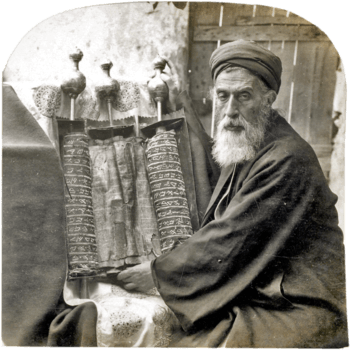Samaritan High Priest
The Samaritan High Priest is the high priest (kohen gadol) of the remaining Samaritan community in the Levant. According to the Samaritan's tradition, the office has existed continuously since the time of Aaron, the brother of Moses, and has been held by 133 priests in the last thirty-four centuries. However, the historicity of this claim is disputable. One account by Josephus suggests that its office holders are an offshoot of the Zadokite high priests of Jerusalem from around the time of Alexander the Great.[1][2]


It appears, based upon the larger gaps in time between high priests, that several names might be missing, or that there were long periods of vacancy between priests.
The continuous lineage of Samaritan High Priests, descending directly from Aaron, through his son Eleazar, and his son Phinehas, was however disrupted in the early 17th century. In 1624, the last Samaritan High Priest of the line of Eleazar son of Aaron died without male succession, but descendants of Aaron's other son, Ithamar, remained and took over the office.[3] There are four families within the house of Ithamar. The Åbtå order, descended from the 113th High Priest Tsedaka ben Tabia, which has held the office of the High Priesthood since 1624; the House of Phineas a.k.a. Dār 'Åder, descended from Fīn'ās ban Yīṣ'å̄q (Phineas ben Isaac); Dār Yīṣ'å̄q, descended from Yīṣ'å̄q ban Åmrām (Isaac ben Amram); and Dār Yāqob, descended from Yāqob ban Årron (Jacob ben Aaron).
List of Samaritan High Priests
- Sashai ben Abishua, who was a contemporary and rival of the Jewish High Priest Eli of Shiloah.
- Bakhi ben Abishua, probably identical to the Jewish High Priest Bukki.
- Shembet ben Nedab ben Uzziah ben Sashai, who served at the shrine to God at Shechem alone.
- Shallum ben Shembet,
- Hezekiah I ben Pedaiel ben Shembet,
- Jonathan I ben Abiathar (2 Samuel 15:27), served as a messenger during Absalom's rebellion (2 Samuel 15:36, 17:17).
- Jair ben Jonathan,
- Daliah I ben Hezekiah,
- Jair II ben Abiezer ben Jair,
- Jonathan II ben Mennah ben Abiezer
- Ishmael ben Koraiah ben Daliah
- Tobiah I
- Zadok
- Amram I
- Hilkiah
- Amram II
- Akkub I
- Akkubiah I ben Hoshea, who was a contemporary of Isaiah and King Hezekiah.
- Hillel
- Seriah
- Levi
- Nathaniel I
- Azariah sat as High Priest during the destruction of the temple in Jerusalem
- Abdael
- Hezekiah II
- Hananiah
- Amram III
- Hanan
- Hezekiah III
- Daliah II
- Akkub II
- Akkubiah II
- Levi I
- Eleazar II
- Manasseh, the son-in-law of Sanballat the governor
- Jair III
- Nathaniel II
- Joiachim
- Jonathan III, High Priest during the lifetime of Jesus
- Elishama, who held the office during the destruction of the second Jerusalem temple
- Shemaiah
- Tobiah II
- Amram IV
- Akabon I
- Phinhas II
- Levi II, who held the office during the revolt of Simon Bar Koziba (Simon bar Kokhba)
- Eleazar III
- Baba I
- Eleazar IV
- Akabon II
- Nathaniel III
- (~308-328 AD[4]) Baba II Rabba, ben Nathaniel
- Akabon III
- Nathaniel IV
- Akabon IV
- Eleazar V
- Akabon V
- Eleazar VI
- Akabon VI, late 6th century
- Eleazar VII
- Netaniel V, early 7th century
- Eleazar VIII, c. 630
- Netaniel VI
- Eleazar IX, 640-650
- Akabon VII
- Eleazar X
- Akabon VIII
- Eleazar XI
- Akabon IX, c. 750
- Eleazar XII, 780-810
- Simeon
- Levi III.
- Phineas III.
- Netaniel VII
- Baba II
- Eleazar XIII.
- Netaniel VIII
- Eleazar XIV
- Phineas IV
- Netaniel IX
- Abdul II
- Eleazar XV
- Abdel III.
- Eleazar XVI
- Aaron II
- Tsedaka
- Amram V
- Aaron III.
- Netaniel X
- Itamar
- Amram VII
- Uzzi
- Joseph
- Phineas V, late 13th century
- Eleazar XVII
- Phineas VI ha-Natzri
- Abisha
- Eleazar XVIII
- Phineas VIII
- (1613–1624) Shelemiah ben Pinhas
- (1624–1650) Tsedaka ben Tabia Ha'abta'ai
- (1650–1694) Yitzhaq ben Tsedaka
- (1694–1732) Abraham ben Yitzhaq
- (1732–1752) Tabia ben Yiszhaq ben Avraham
- (1752–1787) Levi ben Avraham
- (1787–1855) Shalma ben Tabia
- (1855–1874) Amram ben Shalma
- (1874–1916) Yaacob ben Aaharon ben Shalma
- (1916–1932) Yitzhaq ben Amram ben Shalma ben Tabia
- (1933–1943) Matzliach ben Phinhas ben Yitzhaq ben Shalma
- (1943–1961) Abisha ben Phinhas ben Yittzhaq ben Shalma
- (1961–1980) Amram ben Yitzhaq ben Amram ben Shalma
- (1980–1982) Asher ben Matzliach ben Phinhas
- (1982–1984) Phinhas ben Matzliach ben Phinhas
- (1984–1987) Yaacob ben Ezzi ben Yaacob ben Aaharon
- (1987–1998) Yoseph ben Ab-Hisda ben Yaacov ben Aaharon {1919-1998}
- (1998–2001) Levi ben Abisha ben Phinhas ben Yitzhaq {1920-2001}
- (2001–2004) Shalom ben Amram ben Yitzhaq (Saum Is'haq al-Samiri){1922-2004}
- (2004–2010) Elazar ben Tsedaka ben Yitzhaq {1927-2010}
- (2010-2013) Aharon ben Ab-Chisda ben Yaacob
- (2013-) Aabed-El ben Asher ben Matzliach


See also
References
- Josephus (1958). Jewish Antiquities. Loeb Classic Library, Josephus 6: Jewish Antiquities Books 9-11. Translated by Ralph Marcus. Harvard University Press. Book 11, chapter 7.2 – 8, p. 461-483.
- Steinberg, David (20 August 2005). "The Origin and Nature of the Samaritans and their Relationship to Second Temple Jewish Sects". houseofdavid.ca. Section: "The Origin of the Samaritans: What Really Happened?". Retrieved 22 January 2017.
- Sean Ireton (2003). "The Samaritans - A Jewish Sect in Israel: Strategies for Survival of an Ethno-religious Minority in the Twenty First Century". Anthrobase. Retrieved 2007-11-29.
- Cohen, Jeffrey M. (1981). A Samaritan chronicle: a source-critical analysis of the life and times of the great Samaritan reformer, Baba Rabbah. Studia Post-Biblica 30. Leiden: Brill. pp. 225–226. ISBN 9789004062153.